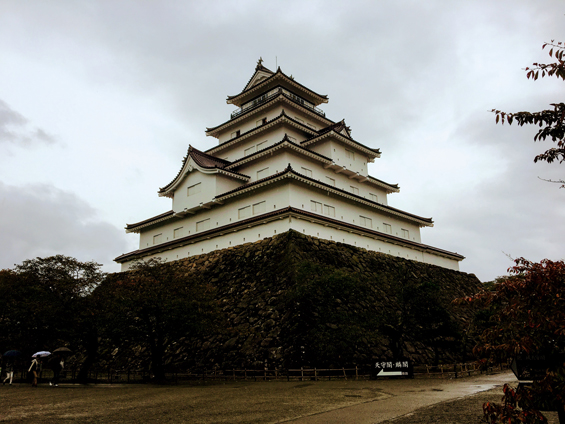
JAPAN SHOWCASE|Tokyo
Northeastern Honshu offers history, scenic villages and fresh seafood
Along the river that runs through the historic town of Aizu-Wakamatsu, in Fukushima Prefecture, stately Japanese inns with wooden facades evoke a sepia-tinted atmosphere of antiquity. Such enclaves of tradition can be found scattered around Fukushima, Japan's third largest province. The sleepy country towns, with their quaint architecture and quiet onsen (hot spring) resorts, offer a serene contrast to the hustle and bustle of life in the exciting megalopolis of Tokyo.

In late October, I set out on a tour of the region supported by Tokyo Metropolitan Government and the tourism bureau of Fukushima Prefecture. The trip began with an introduction to Tokyo's forward-thinking museums. The first stop was the Mori Art Museum, where my travel companions and I took in the sprawling cityscape from the 52nd floor of Roppongi Hills and saw the Sunshower exhibit, which showcased the work of artists in Southeast Asia. After our visit to the museum, we checked out Complex 665, a sleek new addition to the Roppongi modern art scene. At the National Museum of Emerging Science and Innovation, I wandered through the interactive exhibits, perusing dialogues with leading Japanese thinkers on issues such as declining fish stocks and fostering global prosperity. Most impressive, however, was the museum's Geo-Cosmos high-resolution globe, which displays weather patterns in near-real time and tracks statistics such as rising temperatures. According to a representative of the museum, the aim is to “raise awareness of sustainability and show how everything is connected.”
The evening was spent window-shopping at the glitzy new Ginza 6 complex, which is filled with boutiques selling luxury brands from around the world. At the Tsutaya bookshop on the top floor, gorgeous volumes on Japanese art and culture are displayed on six-meter-high shelves. Beneath an expanse of ceiling windows at the center of the store is a gallery space with rotating exhibitions of traditional Japanese crafts. For dinner, we headed to Japanese restaurant Ohashi, tucked along Corridor Gai, a lively nightlife spot crammed with small eateries and bars. Bellies full of sashimi and other seasonal treats, we made our way back to the Tokyu Stay hotel in Shinbashi for the night.

The next morning, we hopped the bullet train from Tokyo station to Fukushima Prefecture. In Aizu-Wakamatsu, we got a crash course in samurai history at Tsuruga Castle, a reconstruction of the military stronghold dating back to 1384. Inside, displays tell the story of the Aizu clan's rise to power, and its eventual overthrow by the Imperial army during the Boshin War in 1868. We hiked up Mount Iinuma, where the tragedy of the byakkotai (White Tiger Brigade) — a troop of young men who committed ritual suicide after Tsuruga Castle was sacked — is enshrined in solemn rows of tombstones. It was dark by the time we reached Harataki Ryokan hot spring resort, and a long soak in the outdoor bath was most welcome. I fell asleep to the gentle murmur of the river outside my window.
En route to the tiny town of Kitakata, we stopped at scenic Ochi-juku, a village of wonderfully preserved old buildings with traditional thatched roofs. Sitting on cushions on the covered terrace, we drank steaming cups of tea with a snack of grilled rice-flour dumplings coated in a sweet and savory miso sauce.

The town of Kitakata is known for its dozens of ramen shops — all within walking distance. At Abe Shokudo, the classic shoyu (soy sauce-based) ramen came with springy noodles submerged in umami-rich broth and topped with thick slices of roast pork. We slurped down our ramen in a former stone kura (storage house), which had been converted into a dining room with tatami-mat flooring, before strolling through the streets lined with restored warehouses.
In the coastal city of Iwaki, life revolves around the sea. The main attraction is the Aquamarine Fukushima Aquarium, which highlights biodiversity in the Shiome Sea. At the Lalamew shopping center, a short drive from the aquarium, fishmongers peddle their wares in an open-air fish market, where you can buy seafood to grill at tables in the back. Like the aquarium, the market still bears traces of the earthquake and tsunami disaster that stuck the region in 2011.

“This is how high the water came,” a shellfish salesman said, pointing to a mark near the ceiling as he hands me a freshly shucked oyster.
But in Iwaki, as elsewhere in Fukushima, life continues, and I was heartened to see communities are thriving once again.
Getting there
From Tokyo to Aizu-Wakamatsu, take the JR Tohoku Shinkansen to Koriyama Station and transfer to a local train on the JR Banetsu-sai Line. The trip takes approximately three hours, costs about ¥9,000 and is covered by the Japan Rail Pass.
Where to stay
In Tokyo: http://www.tokyustay.co.jp/e/hotel/SHI/
In Aizu-Wakamatsu: http://www.yumeguri.co.jp/en/
In Iwaki: http://koito-inn.co.jp/en/
Travel for this article supported by the Tokyo Metropolitan Government















